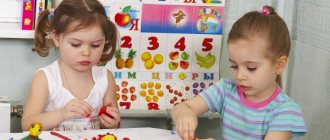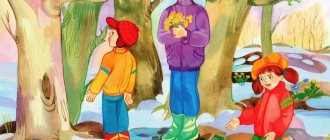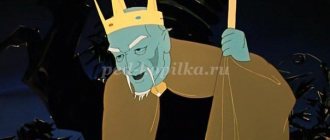Summary of GCD for modeling in kindergarten “Refrigerator for toys”
Summary of GCD for modeling in kindergarten “Refrigerator for toys”
Target
: to develop the ability to work in pairs,
Tasks
.
Arouse interest in creating a collective composition in a toy refrigerator and sculpting its contents (optional). Systematize ideas about the types of products stored in the refrigerator (milk and dairy products, fruits, vegetables, meat, fish, confectionery). Diversify your sculpting technique. Develop a sense of shape and fine motor skills. Cultivate a respectful attitude towards each other, develop the ability to let others act, listen to the opinion of another person, speak out about the opinion heard, and give up the right to another. Preliminary work.
Conversation about the refrigerator, its structure and purpose;
examining the contents of the refrigerator; systematization of products: milk and dairy products, fruits, vegetables, meat, fish, confectionery; preparing the basis for a collective composition from a cardboard box; reading of Tuvim’s poem (translated by S. Mikhalkov) “Vegetables”. A conversation about friendship, about relationships with a friend. Materials, tools, equipment.
Plasticine, stacks, a toy refrigerator, a cook doll in an apron and cap, vegetables and fruits (real or fake), images of various products.
Contents of the lesson.
Children stand in a semicircle, listen. The teacher greets the children.
- Hello guys!
I am very glad to see you in our workshop! Today you will find a surprise, a game and many more interesting things. I want you to succeed and have a good mood all day! - Guys, do you like toys? I have prepared a gift for you! Will you guess my riddle and tell me everything about the answer? This is a wonderful gray wardrobe. Not for dresses and coats. And no one keeps a hat, mittens and scarf in it. He moved into our house. He lives there during the winter! (Refrigerator) I’m very glad that you solved the riddle, now get the answer as a gift! The teacher takes out a toy refrigerator as a gift for the children. - Guys, look, the refrigerator has lost weight and is humming with displeasure. He is in his second day. There is not a grain of sand in his stomach! What foods are stored in the refrigerator? And I suggest you mold the products so that they are very similar to the real thing. Think about what we need to do for this? -There are different products on the table. But you can’t store them all in one pile in the refrigerator, because they all belong to different categories. Now we will take them apart and arrange them so that they each lie in their own container. Dairy products in their own, meat, confectionery, vegetables and fruits each in their own. Guys, look how many there are. Let's split up into pairs to do this work faster. Do you agree? Then I ask you to find a partner and invite him to create a couple. Children pair up. They look into each other's eyes and ask: “Will you work with me?” The teacher asks the children who invited whom to be their partner.
There are cards of different colors on the table, on the back of which products are depicted by category.
Yellow - dairy, Blue - confectionery, Red - meat, Green - vegetables and fruits, So, we have formed pairs. And now I ask you, children, to agree among themselves in pairs, to choose a card by color. Look on the back to see which category you have chosen. Now let’s start disassembling the products in order to then mold them from plasticine into a dollhouse. Children agree and take a card. In the meantime, let's look at them carefully and examine them with our hands - what are they like? What shape, what do they have. So, one, two, three, start laying out the groceries. The teacher asks questions about the shape of objects, color and details. Offers to examine the shape of objects with your hands. Children answer questions, play games, examine and examine objects - It's time to fill our refrigerator with different products, otherwise our dolls are probably already waiting for lunch. –You will have to agree on which products of the category shown on the card your couple will make. One condition, food products should not be repeated. Children agree. The teacher asks each pair what each child will sculpt. Think about what you need for your job. To mold any product, you need to choose the right tools and the right color of plasticine. Someone may need a diagram for sculpting an unfamiliar object. You can come up with your own interesting way to depict the product so that it looks like the real thing. Children choose tools and materials.
Children sit at tables and do their work to the accompaniment of quiet, calm music. The teacher invites the children to sit at the table, monitors their posture and the rules for using plasticine. Conducts individual work with couples. Offers the child a sample sentence on how to properly ask your partner for help. Asks the child to let a friend act. Teaches to listen to the opinion of another person, to speak out about the opinion heard, to give up the right to another. -(Child’s name) ask your partner if he can help you with this and how. -(Child’s name) were you waiting for your friend to do his job? -What did your partner offer you? Do you think he's right or wrong? Why? How should it have been done, in your opinion? - Did you give in to your friend? -Now I ask the couples to bring their work. Come to our refrigerator. What can I say about the refrigerator? We can't live without him. He alone can save all the products. If you want to eat, everything is at hand. If you freeze fruits in the summer, you will eat them in the winter! Analyzes molded products. Which product is most similar to the real thing? Which product is the freshest? Useful? Guys, why did we sculpt the products? What feelings did you experience while sculpting? What can you praise yourself for? What can you praise a friend for? What surprised you? Well done to all of you! We worked hard! You are real masters! They made me and each other happy with their work! Who (child’s name) did you do this work with? Why did you get such a beautiful job and so many products? How did you invite him? How did you work together? Your couple really worked together, which is why you did it so quickly and well. Now let’s go and have some fun, prepare dinner for the dolls, and give them a party! Children take the refrigerator and go to the center of role-playing games. Play with sculpted items
Summary of GCD for modeling in the preparatory group “Furniture for a doll’s house”
Ekaterina Shchirova
Summary of GCD for modeling in the preparatory group “Furniture for a doll’s house”
Summary of GCD for modeling in the preparatory group “Furniture for a doll’s house”
Form of organization:
Group.
Type of lesson:
Artistic and aesthetic (modeling).
Target:
Develop plasticine modeling skills.
Tasks:
1. Continue teaching children to sculpt doll furniture, create objects of different sizes and colors; develop fine motor skills, interest in productive activities, and creative imagination.
2. Learn to select relative and qualitative adjectives; activate the names of pieces of furniture in children’s speech; consolidate the ability to identify a preposition audibly and correctly correlate it with an action.
3. Teach children to negotiate with each other and adequately evaluate their work.
Material:
plasticine, stacks, plates for modeling, napkins, dollhouse, photographs of furniture.
Progress of the lesson
Educator:
We're in trouble; we've lost our doll furniture. Guys, let's make new furniture for our dollhouses. Are you willing to help?
Children:
Yes.
Educator
: Pay attention to the house. It is partially filled with furniture, some rooms are empty.
Educator:
What kind of room do you think is on the second floor?
Children:
Bedroom.
Educator:
- How did you guess?
Children:
There is a bed there.
Educator:
What rooms can be located on the ground floor? Do you know what rooms (living room, kitchen) are already written here?
Educator:
List the pieces of furniture that can be in the living room? (sofa, armchair, coffee table)
- And in the kitchen? (table, stool)
Educator:
- Guys, but don’t forget that the house is a toy and the furniture in it is also a toy. Think and tell me, what can we quickly make doll furniture from? (made of plasticine).
But before we start working, let’s set up our fingers so that they work hard so that the furniture is durable, strong, beautiful, and neat.
Let's play.
Physical education minute:
This is a chair - they sit on it (the left palm in a fist is pressed against the right, fingers extended upward).
This is a table - people sit at it (the left hand is in a fist, the right open palm lies on top)
Here is a bed - they are lying on it (arms bent at the elbows in front of the chest, lying one on top of the other)
We put things away in the closet (imitation of folding things)
And we all work hard (the fingers of both hands walk on the knees)
Educator:
Guys, today you are working in threes - how is that? Look at each other and decide who will work with whom (in a whisper)
— The first three sculpt pieces of furniture for the kitchen.
- The second one is for the living room.
— Go to your workplaces.
- Now you must agree on what piece of furniture each of you will sculpt.
- Look at the pictures, pay attention to the characteristic features of the piece of furniture, what parts the object consists of. Now close your eyes and imagine this object.
Make the furniture not very large, and the sausage legs not too thin, otherwise they will not hold the seat and tabletop.
Bottom line
Educator:
Guys, what did we do today (Children's answers).
Today we worked hard and reviewed everything we learned about furniture.
Analysis of works
Look how beautiful the furniture turned out. I really liked all your works. It’s clear that you all tried very hard, you’re all great.



